I was fortunate enough to find out about an open day at the Malteurop malting plant just up the road from me in Marton, NZ (Google maps view). So my son and I went along to have a look and this is just a report of what we saw and learnt with a few pics to go along. View the whole gallery HERE.
The whole layout of the plant and process is quite simple to see and explain but what was soon evident was the amount of skill required to do such a simple task due to the variability of the barley. Not only do they have to deal with different cultivars but the barley changes depending on the time of year it was harvested and the weather over the season.
The Marton plant plans to process about 60 000t of barley per year of which about half originates from the South Island and is brought up by train from their store in Ashburton. All their barley is grown under contract.
This barley is then stored in silos at about 14% moisture content until it is ready to be malted. There is quite a bit of storage as obviously barley isn't produced all year round.
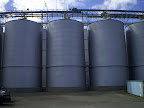
The Marton plant malts 200t of barley at time a time, to that end it has 8 steeping tanks that hold 50t each i.e. 4 tanks needed for a batch. It then has 4 200t bins which then receive a batch and that barley stays in said bin till it is malt i.e. 4 days from go to woe till it is stored as malt.
So firstly some pics of the steeping tanks (they are about 2 stories high):
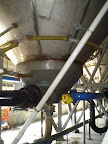

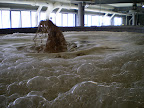
Then we were off to see the first of the 4 bins. Unfortunately I didn't get the exact measurements of these other than they hold 200t of barley. The arm/boom that holds the mixers takes 2 hours to go from end to the other and runs continuously.
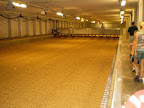
A close up of the mixers
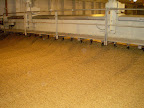
The barley gets into the bins via an auger system that moves it from the silos and drops it down from the roof.
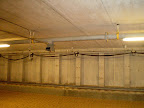
Detail of the mixers

This bin was in the process of being emptied as it was now malt. It was very hot and humid in there - you can see the condensation blurring the pic.
The bins are emptied down the side onto conveyor belts

And the final destination for the malt is another set of silos where it is stored at 4% moisture content and can be kept indefinitely.

We were able to taste the barley from the 4 bins at the various stages of malting which was both interesting and pleasant. Some other interesting bits:
- They use about 700 cubic metres of water a day sourced from a borehole on site.
- All the heating is via steam generated using natural gas.
- Mainly producing pale ale malt, pils malt a bit of munich
- Majority of malt is used locally in NZ with some being exported to the pacific rim
- All malt can be traced back to a specific farm and seed stock. With all details kept regarding the malting process for a particular batch.
- While the automation is handled by a computer a human is still needed to decide on the details of the malting procedure due to the variability of the raw product
Finally I hope I haven't made too many errors in the above and I just want to thank Malteurop for giving the public the opportunity to see what is involved in the malting process. It was a great opportunity and I will probably go to next year's open day with even more questions.
The whole layout of the plant and process is quite simple to see and explain but what was soon evident was the amount of skill required to do such a simple task due to the variability of the barley. Not only do they have to deal with different cultivars but the barley changes depending on the time of year it was harvested and the weather over the season.
The Marton plant plans to process about 60 000t of barley per year of which about half originates from the South Island and is brought up by train from their store in Ashburton. All their barley is grown under contract.
This barley is then stored in silos at about 14% moisture content until it is ready to be malted. There is quite a bit of storage as obviously barley isn't produced all year round.

The Marton plant malts 200t of barley at time a time, to that end it has 8 steeping tanks that hold 50t each i.e. 4 tanks needed for a batch. It then has 4 200t bins which then receive a batch and that barley stays in said bin till it is malt i.e. 4 days from go to woe till it is stored as malt.
So firstly some pics of the steeping tanks (they are about 2 stories high):



Then we were off to see the first of the 4 bins. Unfortunately I didn't get the exact measurements of these other than they hold 200t of barley. The arm/boom that holds the mixers takes 2 hours to go from end to the other and runs continuously.

A close up of the mixers

The barley gets into the bins via an auger system that moves it from the silos and drops it down from the roof.

Detail of the mixers

This bin was in the process of being emptied as it was now malt. It was very hot and humid in there - you can see the condensation blurring the pic.
The bins are emptied down the side onto conveyor belts

And the final destination for the malt is another set of silos where it is stored at 4% moisture content and can be kept indefinitely.

We were able to taste the barley from the 4 bins at the various stages of malting which was both interesting and pleasant. Some other interesting bits:
- They use about 700 cubic metres of water a day sourced from a borehole on site.
- All the heating is via steam generated using natural gas.
- Mainly producing pale ale malt, pils malt a bit of munich
- Majority of malt is used locally in NZ with some being exported to the pacific rim
- All malt can be traced back to a specific farm and seed stock. With all details kept regarding the malting process for a particular batch.
- While the automation is handled by a computer a human is still needed to decide on the details of the malting procedure due to the variability of the raw product
Finally I hope I haven't made too many errors in the above and I just want to thank Malteurop for giving the public the opportunity to see what is involved in the malting process. It was a great opportunity and I will probably go to next year's open day with even more questions.




